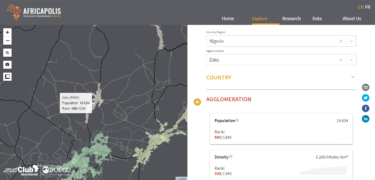While African countries are expected to urbanize at a remarkable rate, it isn’t just its big cities like Johannesberg and Nairobi that need attention.
Thousands of small towns or ‘secondary agglomerations,’ too need equal attention in order to support future populations.
The Organisation for Economic Co-operation and Development (OECD) and Sahel and West Africa Club (SWAC)’s Africapolis provides data for urban planners, researchers, and policy makers, who can plan infrastructure such as housing, schools, and equipment.
Data from Africapolis is helping planners and policymakers focus on the cities that may not be on the level as megacities, but are still set to become pretty big in the future.
Africapolis is a comprehensive and standardized geospatial database on cities and urbanization dynamics in Africa, produced by the SWAC in collaboration with E-geopolis from OECD.
Dr. David Benazeraf, the UrbAfrica Network Coordinator of OECD and SWAC told The Sociable that smaller African agglomerations, with inhabitants between 10,000 and 50,000 are growing.

Dr. David Benazeraf
“People are either moving to the cities or even in very densely populated rural cities, urban agglomerations are emerging, so the future of Africa is urban”
“The future of Africa’s urbanization is not only in large existing cities, but also in tomorrow’s secondary agglomerations, which will grow,” he says.
Urban areas in OECD countries with a population of 1.5 million or more are classified as large metropolitan areas, while 500,000 to 1.5 million are metropolitan areas.
Secondary agglomerations are urban areas with populations between 50,000 and 500,000.
With the OECD predicting that African cities will be housing an additional 950 million people by 2050, the continent is projected to have the fastest urban growth rate in the world.
However, problems lie in the fact that while people are flocking to megacities, the infrastructure may not be up to supporting such overwhelming numbers.
Read More: ASEAN and Korean youth workshop ideas for waste and traffic management
Data and evidence from Africapolis supports cities and governments to make urban areas more inclusive, productive, and sustainable.
Benazeraf says that it’s absolutely key to understand the urbanization trends to promote adequate responses and policies in the region.
“Urbanization is a key trend in Africa, which used to be a vastly rural continent, but it’s becoming more and more urban. So people are either moving to the cities or even in very densely populated rural cities, urban agglomerations are emerging, so the future of Africa is urban.”
How Africapolis Works
Africapolis is a database mapping 7,600 urban agglomerations or towns throughout the African continent.
The project combines data sourced from means like inventories of housing and population censuses, electoral registers, etc., as well as geospatial technologies and Geographic Information System (GIS), which include the use of satellite and aerial images.
“The future of Africa’s urbanization is not only in large existing cities, but also in tomorrow’s secondary agglomerations, which will grow”
Benazeraf informs that usually, international databases look only at the big cities with a threshold of above 300,000 in population. The UN, for instance, looks at only 220 cities. Africapolis looks at urban agglomerations of as low as 10,000 inhabitants.
They do so with the help of satellite images to detect and geo-localize the built-up areas. An urban agglomeration is defined if the space between buildings is less than 200 meters.
“97% of Africapolis urban agglomerations are smaller than 300,000 inhabitants,” he says.
The database, which consists of geo-localized open data, is fully available online and can be downloaded for free. It’s useful for professionals, who need a better understanding of urbanization in Africa.
Read more: How AI, IoT and nanobots can aid parasitic architecture in crowded cities
To explore the tool, a user just has to click on a country on the map of the continent on Africapolis, which then shows all the agglomerates or small towns in that country. Clicking on each displays the name, population ranking, population density, and other available information about the town.
Thus, for example, a promising secondary agglomerate in Nigeria, Zaku, has a population rank of 680/1340, a population density of 5200 inhabitants/sqkm, and is 260 kms away from the next metropolitan agglomeration.

The Rise of Urbanization in Africa
While it’s common knowledge that people are moving from the countryside to the cities, Benazeraf says that in fact, migration isn’t the only factor leading to that.
“There are other big factors, one of them being the urbanization of the rural areas. A densely populated rural area ends up becoming urbanized, when people are no longer looking at agriculture. They start moving to small industries or services,” he says.
According to the UN, in most of Africa, urbanization over the last several decades happened in line with rapid population growth.
For example, for the United Republic of Tanzania it grew from 7.7 million in 1950 to 59 million in 2018. At the same time, the proportion of population in urban settlements rose from 3% to 34%.
Likewise, the population of Ghana increased from 5.0 million in 1950 to 29 million in 2018 while the proportion urban rose from 15% to 56%.
Benazeraf says the emergence of new small towns starting from 10,000 inhabitants can be seen on the rise.
“Of course you have the large cities growing, take the big capital cities, and then you have the new agglomerations appearing. Nigeria, for instance, has more than a thousand urban agglomerations,” he says.
High-Speed Urbanization
In the future, Benazeraf says the Africapolis team looks forward to updating the database even further.
“Because the situation is changing rapidly. We’re talking about high-speed urbanization. We also want to do modeling and projections of the future. So that users can look at the future trends and get an idea of how tomorrow’s cities and urbanization will look like.”
“The situation is changing rapidly. We’re talking about high-speed urbanization”
If the smaller African cities, which aren’t yet overwhelmed with population, are not taken into account now, they will become difficult to manage in the future in terms of urban facilities and infrastructure.
Africapolis helps in focusing on the hundreds of such smaller African agglomerations to ensure their future urbanization is well-managed.












